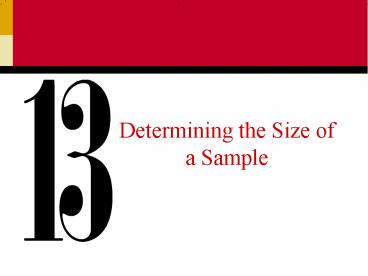Determining the Size of a Sample - PowerPoint PPT Presentation
1 / 17
Title:
Determining the Size of a Sample
Description:
Sample Size and Accuracy ... The Confidence Interval Method of Determining Sample Size ... The relationship between sample size and sample error: ... – PowerPoint PPT presentation
Number of Views:67
Avg rating:3.0/5.0
Title: Determining the Size of a Sample
1
Determining the Size of a Sample
2
Sample Accuracy
- Sample accuracy refers to how close a random
samples statistic is to the true populations
value it represents - Important points
- Sample size is not related to representativeness
- Sample size is related to accuracy
3
Sample Size and Accuracy
- The larger a probability sample is, the more
accurate it is (less sample error).
4
A Picture Says 1,000 Words
n 550 - 2000 1,450 4 - 2 2
Probability sample accuracy (error) can be
calculated with a simple formula, and expressed
as a number.
5
How to Interpret Sample Accuracy
- From a report
- The sample is accurate 7 at the 95 level of
confidence - From a news article
- The accuracy of this survey is 7
6
Sample Size Axioms
- To properly understand how to determine sample
size, it helps to understand the following axioms
7
Sample Size Axioms
- The only perfectly accurate sample is a census.
- A probability sample will always have some
inaccuracy (sample error). - The larger a probability sample is, the more
accurate it is (less sample error).
8
Sample Size Axioms
- A probability sample can be a very tiny
percentage of the population size and still be
very accurate (have little sample error).
9
Sample Size Axiom
- The size of the probability sample depends on the
clients desired accuracy (acceptable sample
error) balanced against the cost of data
collection for that sample size.
10
The Confidence Interval Method of Determining
Sample Size
- This method is based upon the Confidence Interval
and the Central Limit Theorem - Confidence interval range whose endpoints define
a certain percentage of the response to a question
11
The Confidence Interval Method of Determining
Sample Size
- Confidence interval approach applies the
concepts of accuracy, variability, and confidence
interval to create a correct sample size - Two types of error
- Nonsampling error pertains to all sources of
error other than sample selection method and
sample size - Sampling error involves sample selection and
sample size
12
The Confidence Interval Method of Determining
Sample Size
- The relationship between sample size and sample
error
13
Review What does sample accuracy mean?
- 95 Accuracy
- Calculate your samples finding, p
- Calculate your samples accuracy, e
- You will be 95 confident that the population
percentage (p) lies between p e
14
Review What does sample accuracy mean?
- Example
- Sample size of 1,000
- Finding 40 of respondents like our brand
- Sample accuracy is 3 (via our formula)
- So 37 - 43 like our brand
15
Central Limits Theorem
- The central limits theorem allows us to use the
logic of the normal curve distribution. - Since 95 of samples drawn from a population will
fall or 1.96 x sample error (this logic is
based upon our understanding of the normal curve)
we can make the following statement
16
The Confidence Interval Method of Determining
Sample Size
- 1.96 x s.d. defines the endpoints of the
distribution.
17
So, what have we learned thus far?
- There is a relationship between
- The level of confidence we wish to have that our
results would be repeated within some known range
if we were to conduct the study again, and - Variability in the population and
- The amount of acceptable sample error (desired
accuracy) we wish to have and - The size of the sample!

